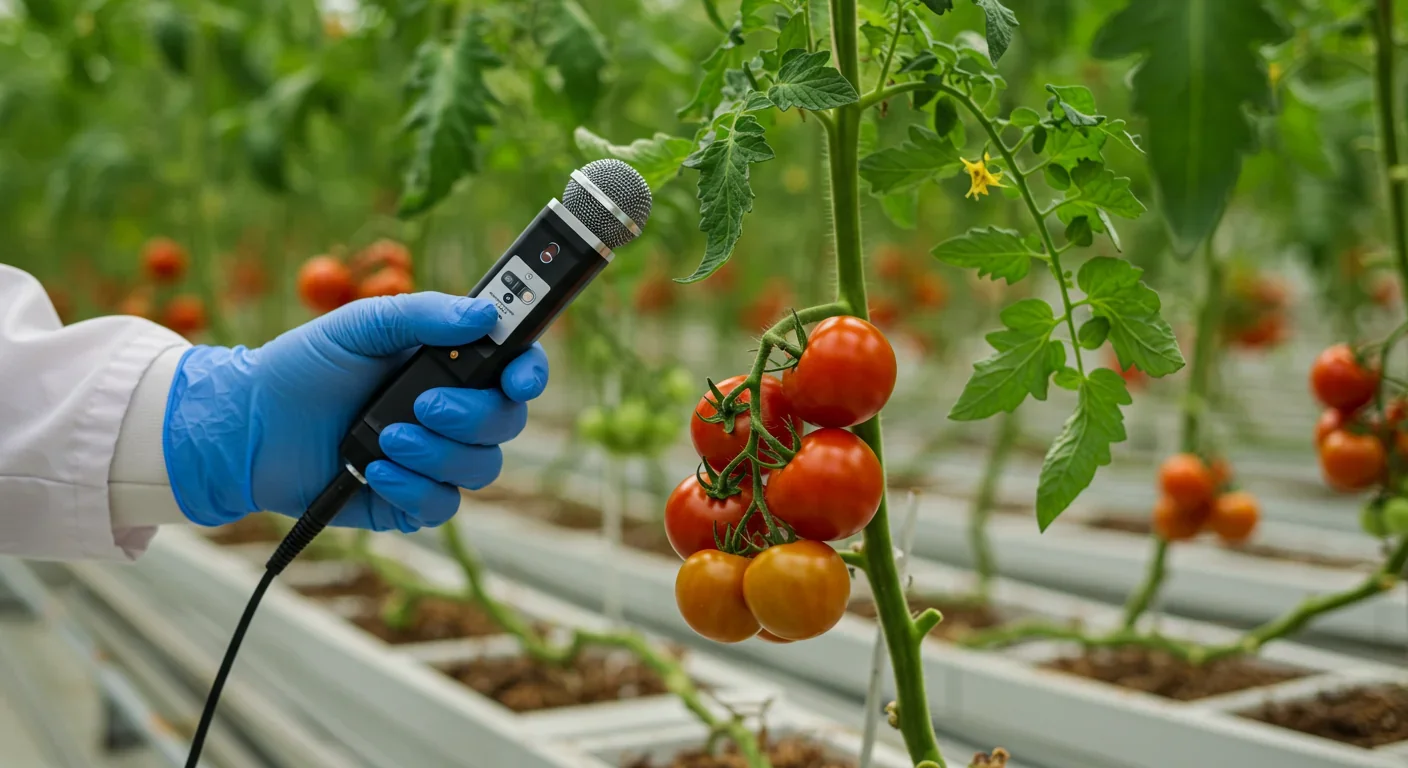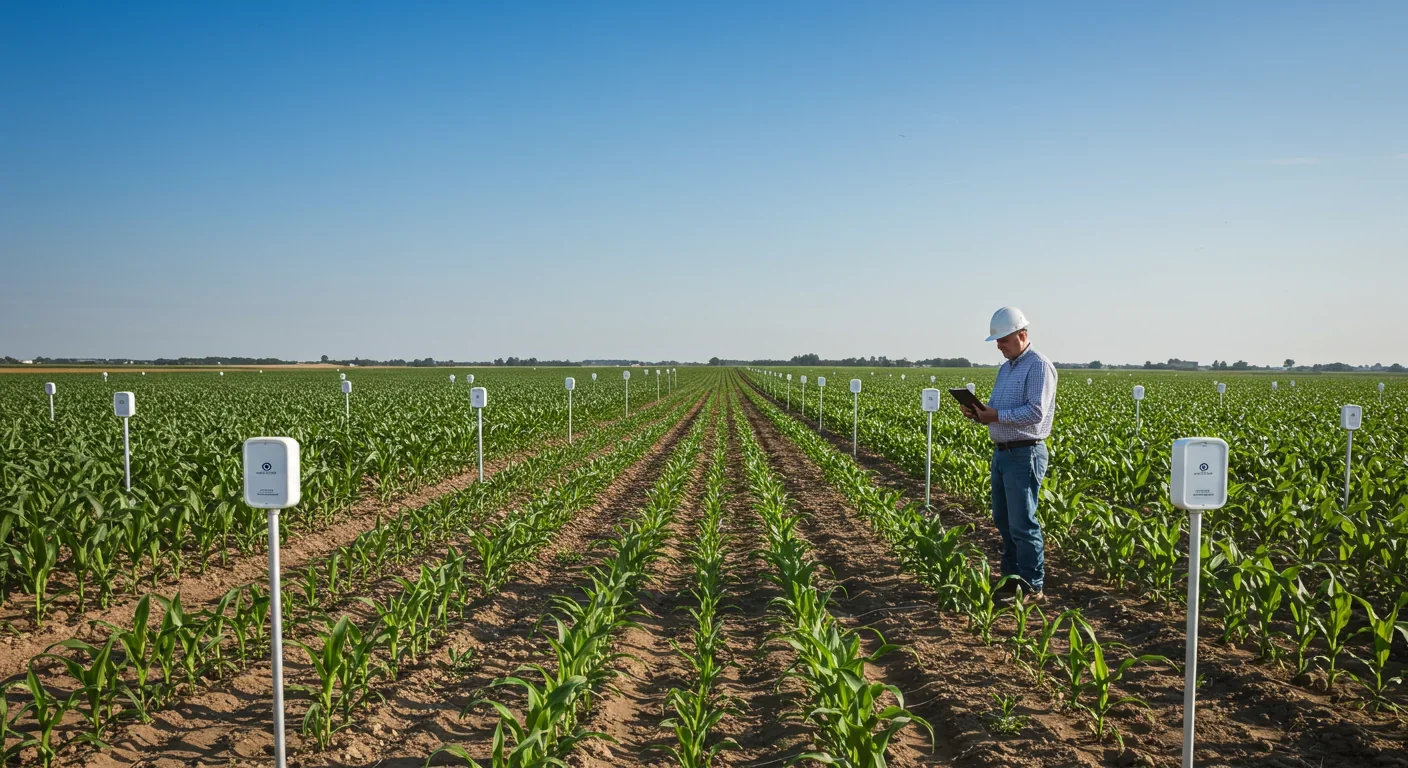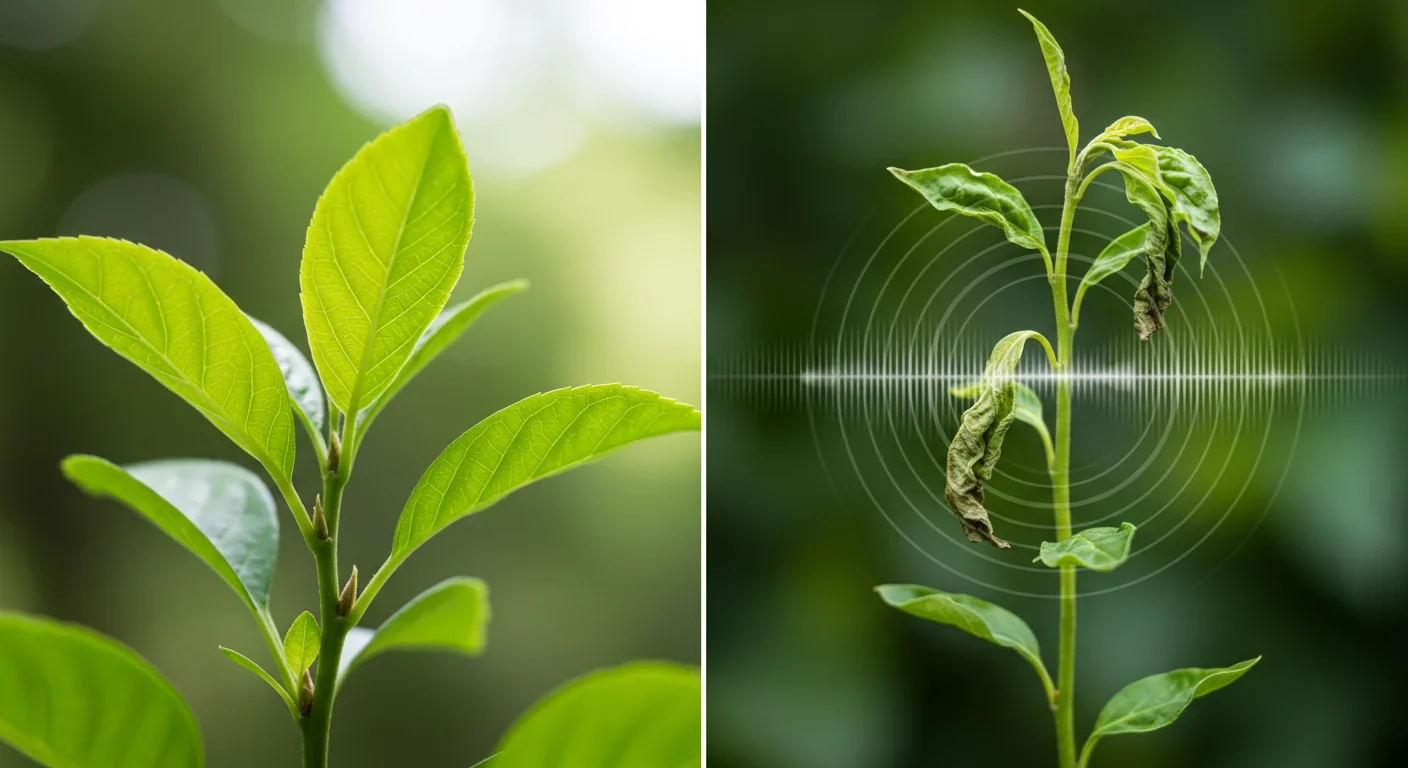Forest Biological Clocks: Ecosystems That Keep Time

TL;DR: Scientists have discovered plants emit ultrasonic clicks and rustles that reveal stress levels, warn neighbors, and may revolutionize agriculture through real-time acoustic monitoring systems.

Walk through a field and you'll hear rustling leaves, maybe birdsong. But beneath that familiar soundscape lies an entire acoustic world we've been deaf to. Plants are talking, screaming, clicking—emitting thousands of ultrasonic signals that reveal their stress levels, warn neighbors of danger, and possibly orchestrate entire ecosystems. Within the next decade, farmers won't just look at their crops. They'll listen to them.
In 2023, evolutionary biologist Lilach Hadany at Tel Aviv University published findings that fundamentally altered how we understand plant communication. Her team placed ultrasonic microphones next to tomato and tobacco plants, recording frequencies between 40-80 kHz—far above human hearing range. Stressed plants—those dehydrated or injured—emitted dozens of clicks per hour. Healthy plants? Less than one click per hour.
These weren't random mechanical noises. Using machine learning algorithms, Hadany's team distinguished between plant species and identified specific stress types from the acoustic patterns alone. Even in noisy greenhouse environments, the AI could diagnose which plants needed water and which had been wounded, all from sound.
The discovery joins a growing body of evidence that plants possess a sophisticated acoustic life. Monica Gagliano's lab at Southern Cross University demonstrated that pea shoots grow toward the sound of running water, proving plants don't just make sounds—they hear them too. The implications ripple far beyond botany labs, touching agriculture, ecology, and our basic understanding of consciousness itself.
How does an organism without vocal cords, lungs, or a brain produce structured acoustic signals? The answer lies in the physics of plant hydraulics.
When plants experience drought stress, tiny air bubbles form inside their xylem vessels—the tubes that carry water from roots to leaves. This process, called cavitation, creates micro-explosions as bubbles collapse. Each collapse generates a sharp, high-frequency click. It's the sound of a plant's circulatory system breaking down.
Wikipedia's plant bioacoustics entry notes that plants emit audio acoustic emissions between 10-240 Hz and ultrasonic emissions within 20-300 kHz. These frequencies span an enormous range. Root clicks typically cluster in the ultrasonic spectrum, while leaf rustles occupy lower frequencies humans can sometimes detect.
Leaf rustles work differently. When wind or other forces disturb leaves, the flexible tissue vibrates, dissipating kinetic energy as sound waves. But recent studies show these vibrations aren't purely passive. Leaf architecture—thickness, texture, venation patterns—determines acoustic properties. Some plants have evolved leaf structures that amplify or dampen specific frequencies, possibly to communicate or defend against herbivores.
Research published in MDPI suggests another mechanism: charged cell membranes. Electrical gradients across plant cells create mechanical vibrations that radiate as acoustic emissions. This hypothesis positions sound production as an integral part of plant physiology, not just a side effect of stress.

The technology detecting these sounds is advancing fast. Traditional microphones miss most plant signals, so researchers use specialized ultrasonic equipment calibrated to capture 20-250 kHz frequencies. MEMS (micro-electromechanical systems) and NEMS (nano-electromechanical systems) sensors can now locate sound sources in three-dimensional space, mapping exactly which part of a plant is stressed.
Early adopters are already deploying this tech. Acoustic sensors can detect insect infestations before visible damage appears, letting farmers apply targeted pesticides instead of blanket treatments. Plant bioacoustics monitoring provides real-time water stress data, optimizing irrigation schedules and preventing drought damage before leaves wilt.
Imagine a vineyard where every grapevine wears a tiny acoustic monitor. When a plant starts clicking rapidly, the system alerts the grower and automatically adjusts drip irrigation to that specific row. No more guesswork, no more flying drones with thermal cameras. Just listen.
The potential extends beyond farms. Forest ecologists could deploy acoustic sensor networks to monitor ecosystem health across vast territories. A sudden increase in ultrasonic emissions might signal an emerging pathogen outbreak or water table drop, providing early warning for conservation interventions.
But are these clicks communication or just noise? The distinction matters enormously for how we interpret the data.
Some researchers argue plant sounds are purely mechanical—incidental byproducts of physical stress with no informational content. Under this view, using acoustic monitoring to detect stress is valuable, but plants aren't "talking" any more than a creaking bridge communicates.
The competing hypothesis suggests plants use acoustic signals deliberately. Research from Kumar (2025) demonstrates that plants respond physiologically to sound waves, triggering growth hormones and defense compounds. If plants both produce and perceive acoustic signals, that's the foundation of a communication system.
Hadany's team believes the sounds carry information detectable by insects, animals, and neighboring plants—all organisms with hearing ranges extending into the ultrasonic. A stressed plant's clicks might warn nearby plants to activate defenses, or signal to pollinators that resources are scarce.
The evidence for inter-plant communication remains circumstantial but intriguing. If confirmed, it would revolutionize ecology, revealing forests and grasslands as acoustic networks where information flows constantly through sound.
Not all plant acoustics research paints an optimistic picture. Urban noise pollution—traffic, construction, aircraft—creates a chronic acoustic assault on city vegetation.
Kumar's research shows continuous loud noise reduces flowering and reproductive output. Plants in noisy environments divert resources to stress responses instead of reproduction, slowly degrading urban ecosystems. The implications for food security are troubling: if agricultural areas near highways or airports experience similar effects, crop yields could suffer invisibly for decades.
This raises uncomfortable questions about our relationship with the living world. We've known for years that noise pollution harms wildlife. Now we're learning it damages plants too. The quiet we've destroyed wasn't empty silence—it was a communication channel millions of species depend on.

Building acoustic monitoring systems for agriculture requires solving several challenges. Field environments are noisy, with wind, insects, machinery, and human activity creating acoustic clutter. Distinguishing genuine plant signals from background requires sophisticated filtering algorithms.
Bio-acoustic sensing systems combine specialized microphones with AI-powered signal processing. Machine learning models trained on thousands of plant recordings can identify species-specific signatures and stress patterns in real time. The systems integrate with existing farm management software, sending alerts when acoustic analysis detects problems.
Power consumption is another hurdle. Continuous ultrasonic monitoring drains batteries quickly, so researchers are developing low-power MEMS sensors that only activate when triggered by specific acoustic patterns. Solar panels and wireless networking enable deployment across large fields without extensive cabling.
Cost remains a barrier to widespread adoption. High-quality ultrasonic microphones still run hundreds of dollars each. But prices are dropping fast as manufacturing scales up. Within five years, acoustic plant monitoring could cost less than existing moisture sensors.
The philosophical implications extend beyond agriculture. If plants communicate acoustically, respond to sounds from their environment, and potentially coordinate behavior through acoustic networks, where do we draw the line between reaction and communication? Between mechanism and meaning?
We're not suggesting plants are conscious in the way animals are. But they clearly process information about their environment, make decisions about resource allocation, and interact with other organisms through chemical and potentially acoustic signaling. That's a form of intelligence, even if it operates on timescales and through mechanisms radically different from our own.
Research published in The Naturalist frames this as plants actively processing acoustic environments and integrating sound into ecological decision-making. A plant "choosing" to grow roots toward the sound of water isn't so different from an animal walking toward a sound—both represent directed responses to acoustic information.
The discovery of plant acoustic communication fits a broader trend in biology: the more we study non-human and especially non-animal organisms, the more we find sophisticated behaviors we'd once dismissed as impossible without brains. Slime molds solve mazes. Bacteria form complex social structures. Plants talk.
Different regions are approaching plant acoustic technology from varying angles. Israeli researchers lead in basic science, pushing the boundaries of what we know about plant communication. European agricultural technology firms are commercializing acoustic monitoring systems for high-value crops like vineyards and greenhouse vegetables.
In Asia, where precision agriculture faces different constraints—smaller farms, higher labor costs—acoustic monitoring offers a way to maximize productivity without expanding cultivated area. Japan and South Korea are integrating plant bioacoustics into smart farming initiatives that combine robotics, AI, and sensor networks.
African agricultural researchers see potential for acoustic monitoring in water-scarce regions, where detecting drought stress early can make the difference between harvest and failure. The technology's non-invasive nature—no soil sampling, no tissue analysis—makes it particularly suitable for resource-limited settings.
Latin American coffee and cacao producers are experimenting with acoustic sensors to optimize fertilization and irrigation, reducing chemical inputs while maintaining yield. The potential environmental benefits are substantial: fewer pesticides, less water waste, higher productivity per hectare.
Within five years, expect to see acoustic monitoring as a standard option in farm management systems. Commercial greenhouses and high-value orchards will likely adopt first, followed by row crops as costs decrease.
If you work in agriculture, start paying attention to bioacoustic technology companies and pilot programs. The competitive advantage of early stress detection could be substantial. For everyone else, the transformation will be subtler but equally significant.
We're learning that the living world communicates in languages we've only begun to decipher. Every field, every forest, every garden hums with acoustic signals carrying information about stress, health, and environmental conditions. We're finally developing ears to hear it.
The implications ripple outward from farming into ecology, conservation, and our basic understanding of what it means to be alive. In a world of talking plants, silence will never sound the same.
As Lilach Hadany puts it: "Even in a quiet field, there are actually sounds that we don't hear, and those sounds carry information." We're learning to listen. What we hear might change everything.

MOND proposes gravity changes at low accelerations, explaining galaxy rotation without dark matter. While it predicts thousands of galaxies correctly, it struggles with clusters and cosmology, keeping the dark matter debate alive.

Ultrafine pollution particles smaller than 100 nanometers can bypass the blood-brain barrier through the olfactory nerve and bloodstream, depositing in brain tissue where they trigger neuroinflammation linked to dementia and neurological disorders, yet remain completely unregulated by current air quality standards.

CAES stores excess renewable energy by compressing air in underground caverns, then releases it through turbines during peak demand. New advanced adiabatic systems achieve 70%+ efficiency, making this decades-old technology suddenly competitive for long-duration grid storage.

Our brains are hardwired to see patterns in randomness, causing the gambler's fallacy—the mistaken belief that past random events influence future probabilities. This cognitive bias costs people millions in casinos, investments, and daily decisions.

Forests operate as synchronized living systems with molecular clocks that coordinate metabolism from individual cells to entire ecosystems, creating rhythmic patterns that affect global carbon cycles and climate feedback loops.

Generation Z is the first cohort to come of age amid a polycrisis - interconnected global failures spanning climate, economy, democracy, and health. This cascading reality is fundamentally reshaping how young people think, plan their lives, and organize for change.

Zero-trust security eliminates implicit network trust by requiring continuous verification of every access request. Organizations are rapidly adopting this architecture to address cloud computing, remote work, and sophisticated threats that rendered perimeter defenses obsolete.